Preparation of UV Curable Optical Adhesive NOA81 Bionic Lotus Leaf Structure Films by Nanoimprint Technique and the Applications on Silicon Solar Cells
Abstract
:1. Introduction
2. Experiment
3. Results and Discussion
4. Conclusions
Author Contributions
Funding
Data Availability Statement
Conflicts of Interest
References
- Abdullah, M.F.; Alghoul, M.A.; Naser, H.; Asim, N.; Ahmadi, S.; Yatim, B.; Sopian, K. Research and development efforts on texturization to reduce the optical losses at front surface of silicon solar cell. Renew. Sust. Energ. Rev. 2016, 66, 380–398. [Google Scholar] [CrossRef]
- Alves, M.; Perez-Rodriguez, A.; Dale, P.J.; Dominguez, C.; Sadewasser, S. Thin-film micro-concentrator solar cells. J. Phys. Energy 2020, 2, 012001. [Google Scholar] [CrossRef]
- Zhang, T.; Gregoriou, V.G.; Gasparini, N.; Chochos, C.L. Porous organic polymers in solar cells. Chem. Soc. Rev. 2022, 51, 4465–4483. [Google Scholar] [CrossRef]
- Schygulla, P.; Heinz, F.D.; Dimroth, F.; Lackner, D. Middle Cell Development for Wafer-Bonded III-V//Si Tandem Solar Cells. IEEE J. Photovolt. 2021, 11, 1264–1270. [Google Scholar] [CrossRef]
- Aat, A.; Ap, B. Efficiency improvement of a silicon-based thin-film solar cell using plasmonic silver nanoparticles and an antireflective layer. Opt. Commun. 2020, 454, 124437. [Google Scholar]
- Yamaguchi, M.; Lee, K.-H.; Araki, K.; Kojima, N.; Ohshita, Y. Analysis for efficiency potential of crystalline Si solar cells. J. Mater. Res. 2018, 33, 2621–2626. [Google Scholar] [CrossRef]
- Zhao, J.; Wang, A.; Green, M.A. 24·5% Efficiency silicon PERT cells on MCZ substrates and 24·7% efficiency PERL cells on FZ substrates. Prog. Photovolt. Res. Appl. 1999, 7, 471–474. [Google Scholar] [CrossRef]
- Bozzola, A.; Liscidini, M.; Andreani, L.C. Broadband light trapping with disordered photonic structures in thin-film silicon solar cells. Prog. Photovolt. 2015, 22, 1237–1245. [Google Scholar] [CrossRef]
- Tucher, N.; Eisenlohr, J.; Gebrewold, H.; Kiefel, P.; Höhn, O.; Hauser, H.; Goldschmidt, J.C.; Bläsi, B. Optical simulation of photovoltaic modules with multiple textured interfaces using the matrix-based formalism OPTOS. Opt. Express 2016, 24, A1083–A1093. [Google Scholar] [CrossRef]
- Andreani, L.C.; Bozzola, A.; Kowalczewski, P.; Liscidini, M.; Redorici, L. Silicon solar cells: Toward the efficiency limits. Adv. Phys. X 2019, 4, 1548305. [Google Scholar] [CrossRef]
- Matsui, T.; Sai, H.; Bidiville, A.; Hsu, H.-J.; Matsubara, K. Progress and limitations of thin-film silicon solar cells. Sol. Energy 2018, 170, 486–498. [Google Scholar] [CrossRef]
- Suhandi, A.; Tayubi, Y.R.; Wibowo, F.C.; Arifin, P.; Supriyatman. Reducing The Light Reflected by Silicon Surface Using ZnO/TS Antireflection Coating. J. Phys. D 2017, 877, 012068. [Google Scholar] [CrossRef]
- Chen, L.; Wang, Y.; Qian, H.; Lu, H.; Chen, R.; Jian, Y.; Li, G.; Zhu, J.; Shi, Z.; Power, W.S. STUDY OF PERL MONOCRYSTALLINE SILICON SOLAR CELLS. Taiyangneng Xuebao/Acta Energ. Sol. Sin. 2013, 34, 2170–2174. [Google Scholar]
- Salman, K.A. Effect of surface texturing processes on the performance of crystalline silicon solar cell. Sol. Energy 2017, 147, 228–231. [Google Scholar] [CrossRef]
- Li, R.; Li, X.; Zou, T.; Fu, W.; Xing, J.; Huang, T.; Yu, Z.; Yang, J. Deep investigation of two-dimensional structure arrays formed on Si surface. Appl. Surf. Sci. 2022, 605, 154615. [Google Scholar] [CrossRef]
- Li, C.-H.; Zhao, J.-H.; Yu, X.-Y.; Chen, Q.-D.; Feng, J.; Sun, H.-B. Fabrication of Black Silicon With Thermostable Infrared Absorption by Femtosecond Laser. IEEE Photonics J. 2016, 8, 6805809. [Google Scholar] [CrossRef]
- Bian, C.; Zhang, B.; Zhang, Z.; Chen, H.; Zhang, D.; Wang, S.; Ye, J.; He, L.; Jie, J.; Zhang, X. Wafer-Scale Fabrication of Silicon Nanocones via Controlling Catalyst Evolution in All-Wet Metal-Assisted Chemical Etching. ACS Omega 2022, 7, 2234–2243. [Google Scholar] [CrossRef] [PubMed]
- Yamada, K.; Yamada, M.; Maki, H.; Itoh, K.M. Fabrication of arrays of tapered silicon micro-/nano-pillars by metal-assisted chemical etching and anisotropic wet etching. Nanotechnology 2018, 29, 28LT01. [Google Scholar] [CrossRef]
- Kumar, J.; Ingole, S. Effect of Silicon Conductivity and HF/H2O2 Ratio on Morphology of Silicon Nanostructures Obtained via Metal-Assisted Chemical Etching. J. Electron. Mater. 2017, 47, 1583–1588. [Google Scholar] [CrossRef]
- Zhang, B.; Jie, J.; Zhang, X.; Ou, X.; Zhang, X. Large-Scale Fabrication of Silicon Nanowires for Solar Energy Applications. ACS Appl. Mater. Interfaces 2017, 9, 34527–34543. [Google Scholar] [CrossRef]
- Kosloff, A.; Heifler, O.; Granot, E.; Patolsky, F. Nanodicing Single Crystalline Silicon Nanowire Arrays. Nano Lett. 2016, 16, 6960–6966. [Google Scholar] [CrossRef]
- Wendisch, F.J.; Rey, M.; Vogel, N.; Bourret, G.R. Large-Scale Synthesis of Highly Uniform Silicon Nanowire Arrays Using Metal-Assisted Chemical Etching. Chem. Mater. 2020, 32, 9425–9434. [Google Scholar] [CrossRef] [PubMed]
- Aurang, P.; Turan, R.; Unalan, H.E. Nanowire decorated, ultra-thin, single crystalline silicon for photovoltaic devices. Nanotechnology 2017, 28, 405205. [Google Scholar] [CrossRef] [PubMed]
- Savin, H.; Repo, P.; von Gastrow, G.; Ortega, P.; Calle, E.; Garin, M.; Alcubilla, R. Black silicon solar cells with interdigitated back-contacts achieve 22.1% efficiency. Nat. Nanotechnol. 2015, 10, 624–628. [Google Scholar] [CrossRef]
- Ingenito, A.; Isabella, O.; Zeman, M. Nano-cones on micro-pyramids: Modulated surface textures for maximal spectral response and high-efficiency solar cells. Prog. Photovolt. 2015, 23, 1649–1659. [Google Scholar] [CrossRef]
- Kanda, H.; Shibayama, N.; Uzum, A.; Umeyama, T.; Imahori, H.; Ibi, K.; Ito, S. Effect of Silicon Surface for Perovskite/Silicon Tandem Solar Cells: Flat or Textured? ACS Appl. Mater. Interfaces 2018, 10, 35016–35024. [Google Scholar] [CrossRef]
- Jošt, M.; Köhnen, E.; Morales-Vilches, A.B.; Lipovšek, B.; Jäger, K.; Macco, B.; Al-Ashouri, A.; Krč, J.; Korte, L.; Rech, B.; et al. Textured interfaces in monolithic perovskite/silicon tandem solar cells: Advanced light management for improved efficiency and energy yield. Energ. Environ. Sci. 2018, 11, 3511–3523. [Google Scholar] [CrossRef]
- Tamang, A.; Hongsingthong, A.; Jovanov, V.; Sichanugrist, P.; Khan, B.A.; Dewan, R.; Konagai, M.; Knipp, D. Enhanced photon management in silicon thin film solar cells with different front and back interface texture. Sci. Rep. 2016, 6, 29639. [Google Scholar] [CrossRef]
- Deng, K.; Liu, Z.; Wang, M.; Li, L. Nanoimprinted Grating-Embedded Perovskite Solar Cells with Improved Light Management. Adv. Funct. Mater. 2019, 29, 1900830. [Google Scholar] [CrossRef]
- Steinbach, A.M.; Kazemi, S.B.; Strehle, S. Solid-liquid-vapor etching of silicon nanostructures using hydrogen plasma. Phys. Status Solidi (A) 2016, 213, 2921–2926. [Google Scholar] [CrossRef]
- Manzoor, S.; Yu, Z.J.; Ali, A.; Ali, W.; Bush, K.A.; Palmstrom, A.F.; Bent, S.F.; McGehee, M.D.; Holman, Z.C. Improved light management in planar silicon and perovskite solar cells using PDMS scattering layer. Sol. Energ. Mat. Sol. C. 2017, 173, 59–65. [Google Scholar] [CrossRef]
- Kryuchkov, M.; Lehmann, J.; Schaab, J.; Cherepanov, V.; Blagodatski, A.; Fiebig, M.; Katanaev, V.L. Alternative moth-eye nanostructures: Antireflective properties and composition of dimpled corneal nanocoatings in silk-moth ancestors. J. Nanobiotechnol. 2017, 15, 61. [Google Scholar] [CrossRef] [PubMed]
- Guo, X.; Song, H.; Du, B.; Tan, S.; Liu, S. Study on Spectral Selective Manipulation Characteristics of Surface Multilevel Micro-Nano Structures by FDTD Simulation. Int. J. Mol. Sci. 2022, 23, 2774. [Google Scholar] [CrossRef] [PubMed]
- Zhang, X.; Bi, Y.; Liu, S.; Zhang, W.; Hu, F. Organic–Inorganic Hybrid Film MLAs Built on the Silicon Solar Cells to Improve the Photoelectric Conversion Efficiency. Coatings 2022, 12, 393. [Google Scholar] [CrossRef]

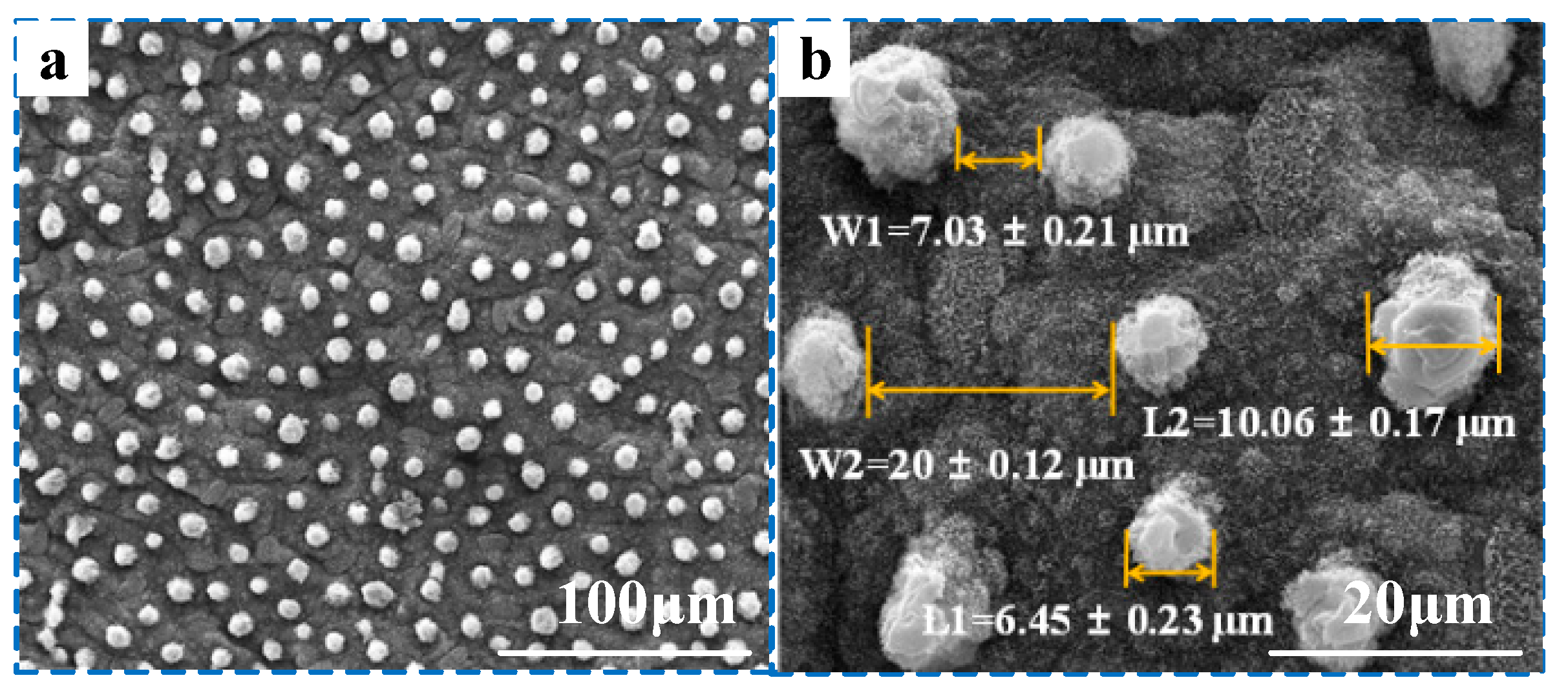

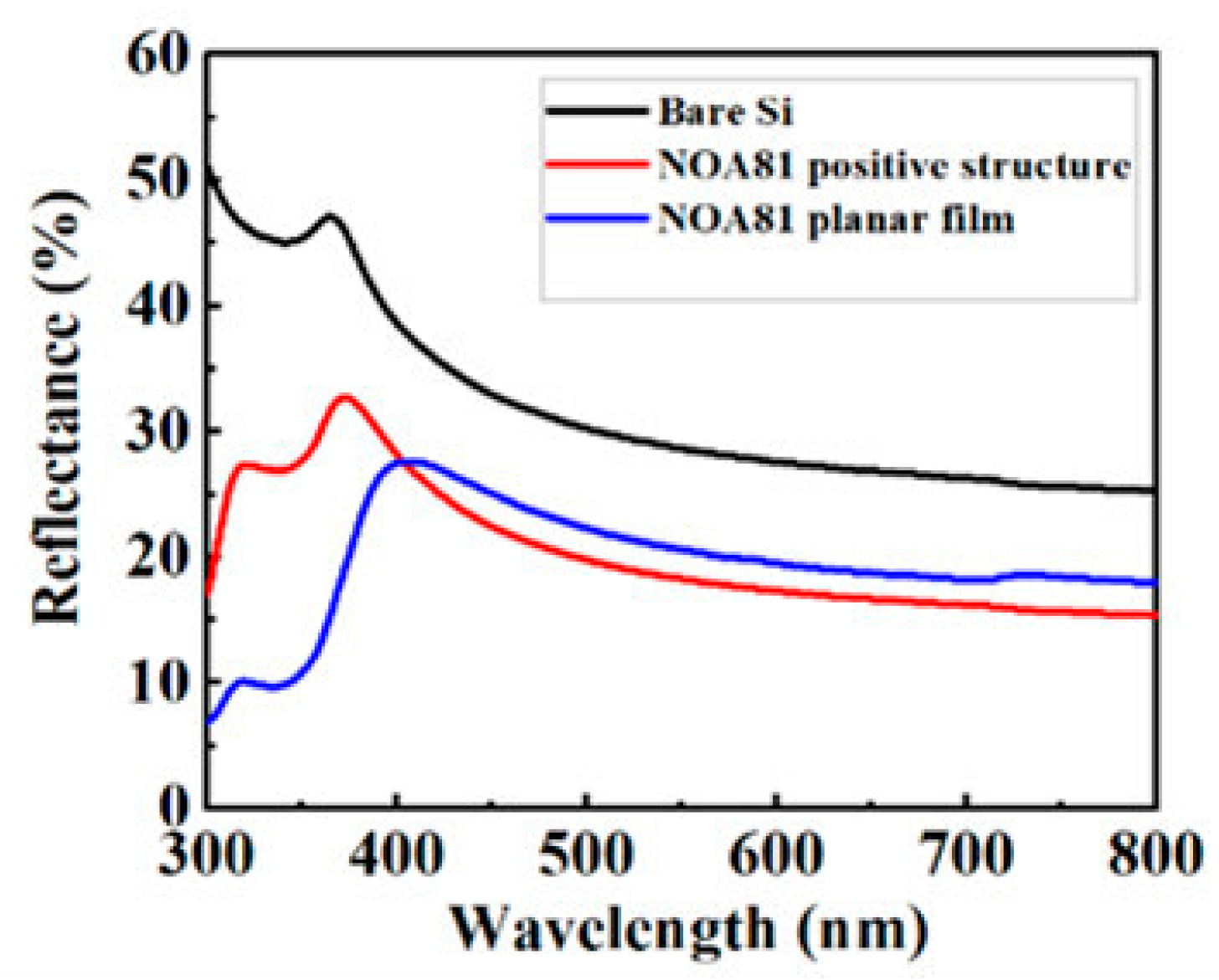
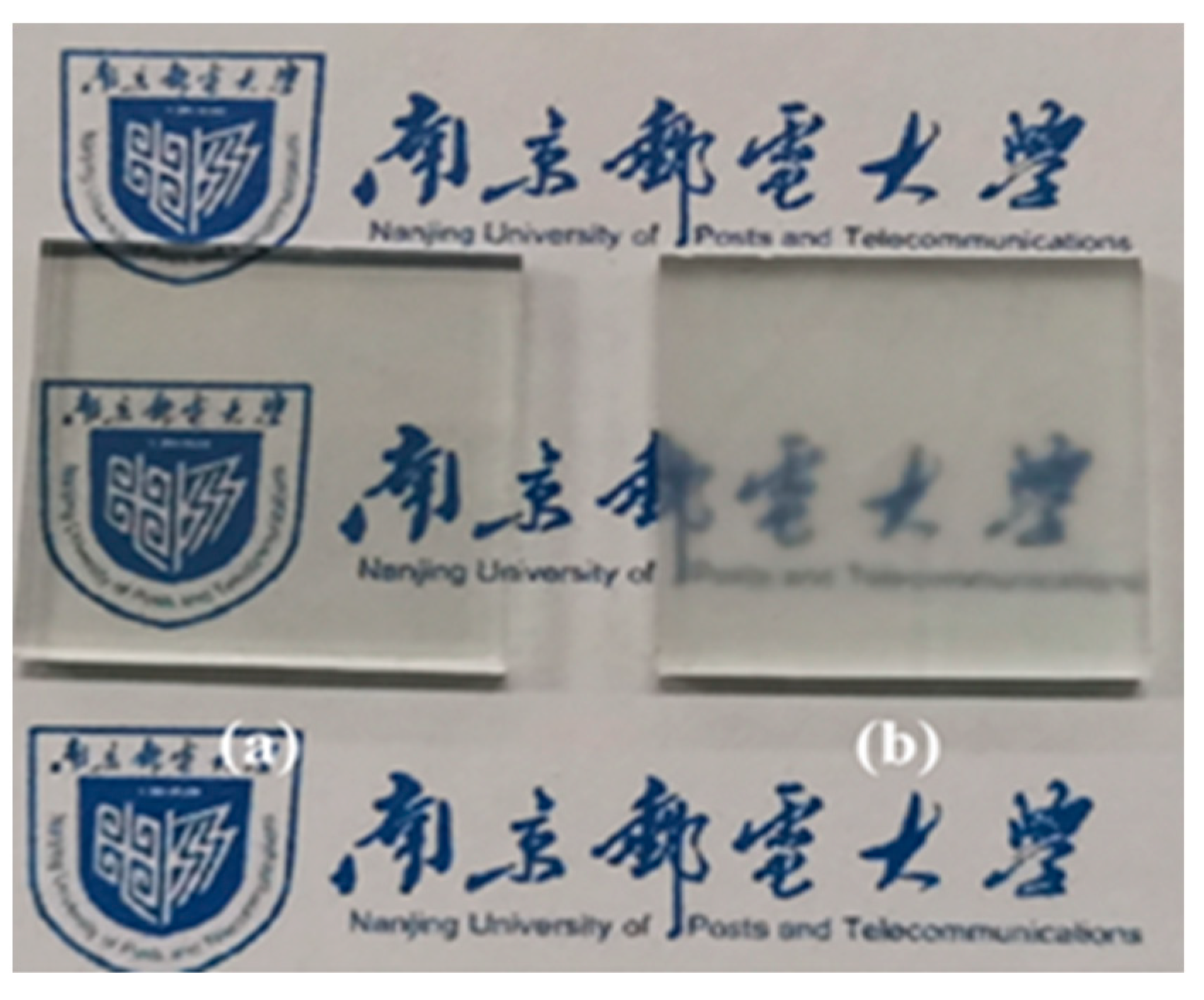
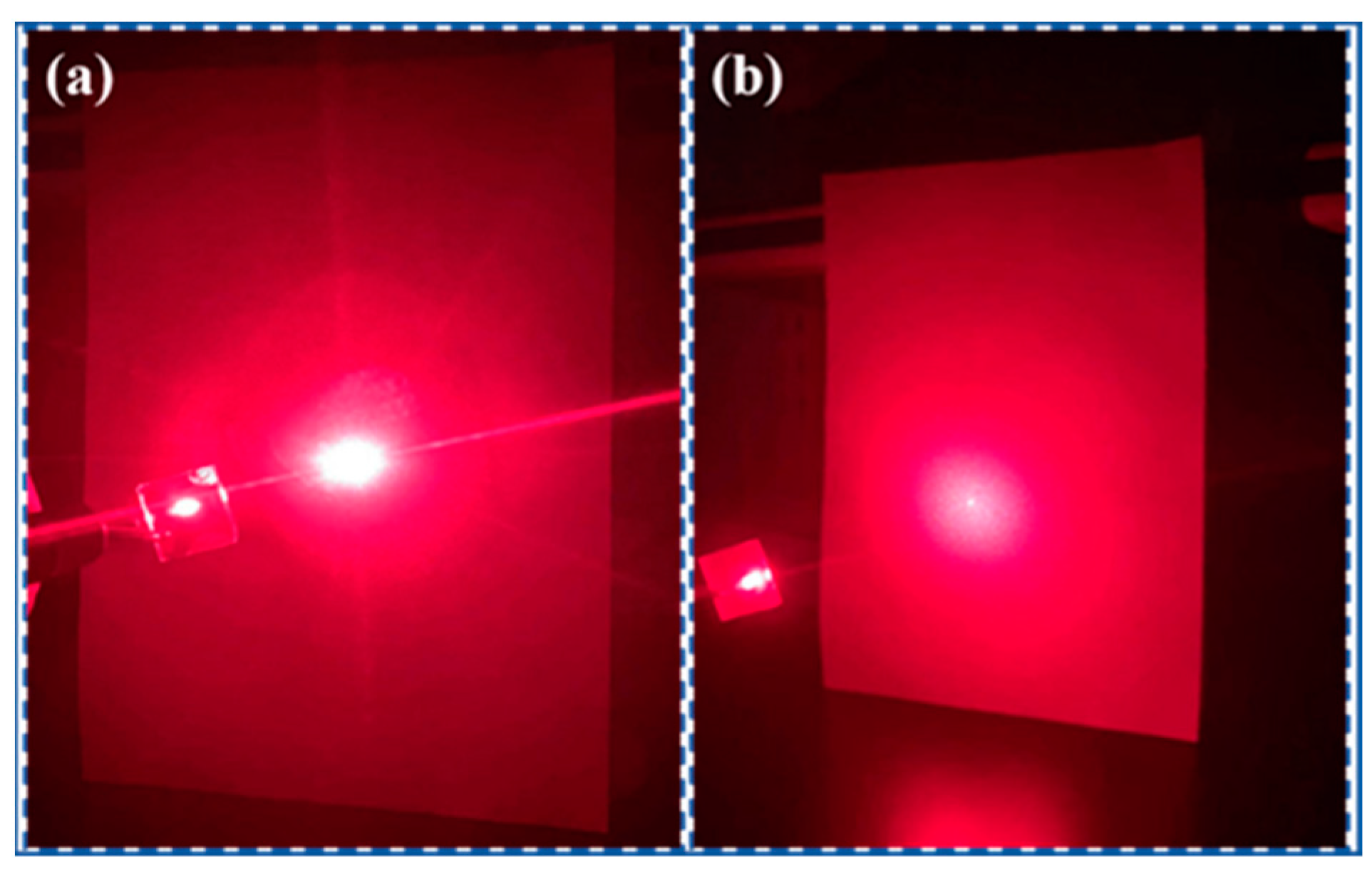

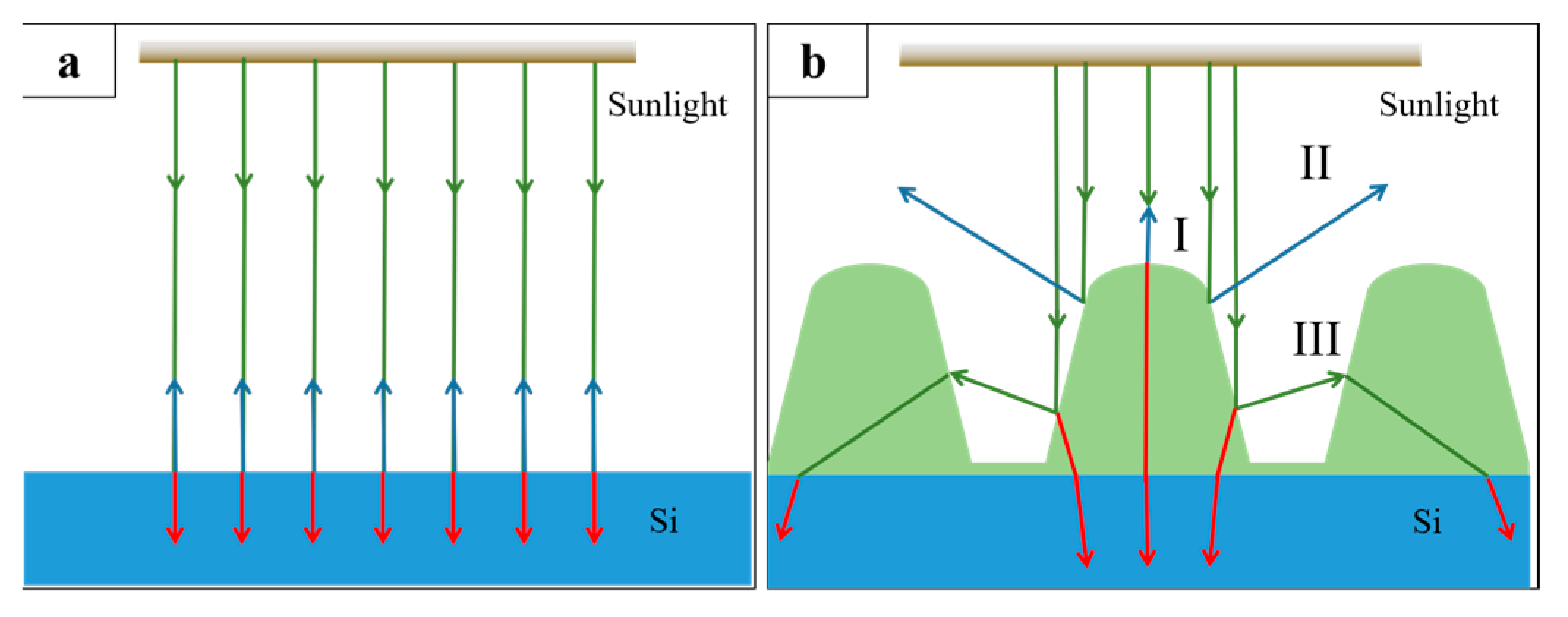
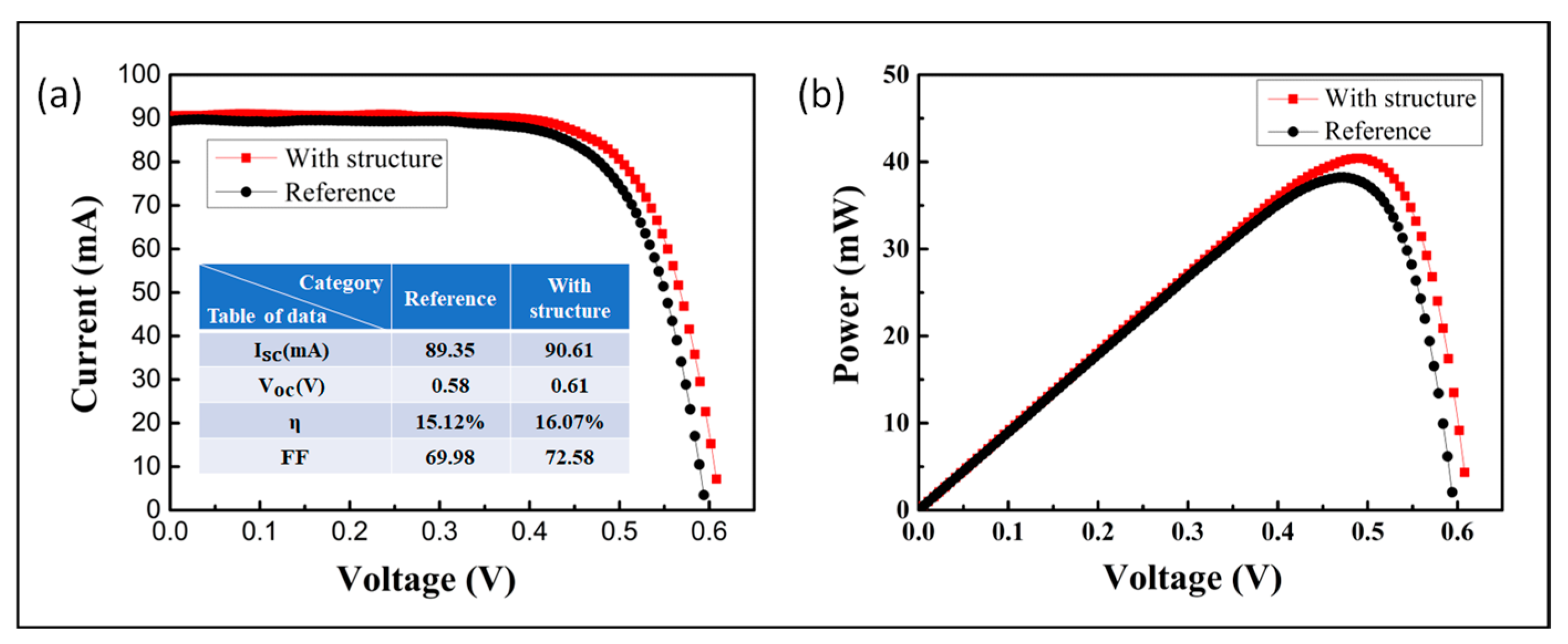
Disclaimer/Publisher’s Note: The statements, opinions and data contained in all publications are solely those of the individual author(s) and contributor(s) and not of MDPI and/or the editor(s). MDPI and/or the editor(s) disclaim responsibility for any injury to people or property resulting from any ideas, methods, instructions or products referred to in the content. |
© 2023 by the authors. Licensee MDPI, Basel, Switzerland. This article is an open access article distributed under the terms and conditions of the Creative Commons Attribution (CC BY) license (https://creativecommons.org/licenses/by/4.0/).
Share and Cite
Zhang, X.; Zhang, P.; Zhang, W.; Chen, J.; Hu, F. Preparation of UV Curable Optical Adhesive NOA81 Bionic Lotus Leaf Structure Films by Nanoimprint Technique and the Applications on Silicon Solar Cells. Coatings 2023, 13, 867. https://doi.org/10.3390/coatings13050867
Zhang X, Zhang P, Zhang W, Chen J, Hu F. Preparation of UV Curable Optical Adhesive NOA81 Bionic Lotus Leaf Structure Films by Nanoimprint Technique and the Applications on Silicon Solar Cells. Coatings. 2023; 13(5):867. https://doi.org/10.3390/coatings13050867
Chicago/Turabian StyleZhang, Xuehua, Pei Zhang, Wei Zhang, Jing Chen, and Fangren Hu. 2023. "Preparation of UV Curable Optical Adhesive NOA81 Bionic Lotus Leaf Structure Films by Nanoimprint Technique and the Applications on Silicon Solar Cells" Coatings 13, no. 5: 867. https://doi.org/10.3390/coatings13050867




